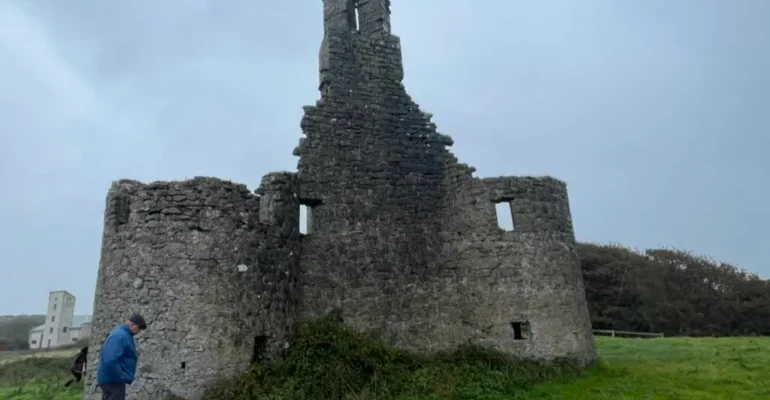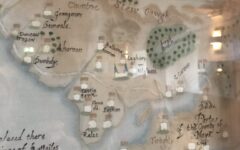Ardnaree Castle Rediscovered: The Foundation Stone of Ballina Reclaimed
July 6, 2025 2025-09-27 23:20Ardnaree Castle Rediscovered: The Foundation Stone of Ballina Reclaimed
For more information, follow this link!
In the crook of the River Moy’s eastward bend, hidden beneath centuries of soil and silence, a fortress long thought lost to history has reemerged. Ardnaree Castle, once central to Ballina’s birth and bloodshed, has officially returned to Ireland’s historical record, not through academic decree or government grant, but through the relentless passion of a small team of local heroes.
At the heart of this rediscovery is the Ardnaree Preservation Group, a grassroots alliance of four Ballina locals: Dermot Rice and Martin Devaney from the Ballina Community Clean-Up project, and Colin McLaughlin and Tomás Joyce, two men with a fierce commitment to historical truth. Their mission was to find, confirm, and reclaim the site of Ardnaree Castle, a structure central to the Battle of Ardnaree in 1586, where Irish and Scottish soldiers were massacred by English forces. For decades, the castle’s location was lost, erased from maps, faded into folklore.
But folklore never forgets.
From Community Clean-Up to Historic Breakthrough
Dermot Rice, a driving force in the Ballina Community Clean-Up, described how this journey began not with ground-penetrating radar or LIDAR, but with garbage bags and gumption. As the clean-up group planned a community art installation to honour the Battle of Ardnaree, they found themselves drawn into deeper research. One layer led to another—art led to a documentary, which led to song, which led to stories… and then, something unexpected: an old tale of a castle, passed down in hushed tones and handwritten memories.
“It was off the map,” Dermot said. “Completely invisible. But through oral history, old maps, and local knowledge, we found the hill.”
Enter the Archaeologist: Evidence Rises from the Earth
Tomás Joyce, a seasoned archaeologist with over two decades of field experience, received the call in February. What began as curiosity quickly became conviction. Joyce recalls, “Among the older stock of Ardnaree, it was always said there was a castle. This wasn’t just speculation. The oral tradition never died.”
The team uncovered a striking entry in the National Folklore Schools’ Collection—a tale by Joseph Kilcullen from 1937–1939, describing a castle on Palmyra Castle Hill, still remembered over 100 years after it was declared ruined in 1829.
Using primary and secondary sources, they stitched together a compelling case—so compelling, in fact, that on June 6th, 2025, the National Monument Service of Ireland added Ardnaree Castle to its Historic Environment Viewer. The long-lost stronghold was no longer lost.
A Site of Slaughter and Symbolism
Ardnaree Castle’s position is more than strategic; it’s sacred. Perched on the 10-metre contour, overlooking the River Moy, it forms one half of a gruesome geographic duet. Directly across the river lies the Dolmen of the Fir Bolg, where oral tradition says the remains of slain invaders were carried and buried. Between them flows memory.
And fate, it seems, played a role. The community art installation created to commemorate the Battle of Ardnaree now stands mere metres from the rediscovered castle site—the very bend in the river where, according to local history, the bodies of civilians floated after the 1586 massacre. As Dermot said, “It’s like the hand of history pulled us to the exact spot. That wall, that artwork—it is, quite literally, ground zero.”
The Hill of Executions: What’s in a Name?
The name “Ardnaree” itself holds secrets. Deriving from ancient Irish, it is thought to mean “Hill of Executions.” According to a 6th-century tale, a bishop named Calloch was murdered by the Formae Wailes. Their punishment? Execution at Ardnaree—their bones ferried across the Moy to the dolmen still visible today. In this mythology, justice, faith, and violence carved the landscape we walk upon.
Reclaiming the Foundation Stone of Ballina
The team now refers to the castle site as nothing less than the “foundation stone of Ballina.” It predates the Augustinian Abbey, which celebrates its 600th anniversary in 2027. The castle’s rediscovery is not just a victory for heritage—it is a reclamation of Ballina’s origin story.
As Thomas Joyce reflects, “We’ve only scratched the surface.” There’s more to find, more to tell, and if this team’s persistence is any indication, the future of Ballina’s past is in very good hands.
A New Era for Heritage Tourism?
With the castle now officially protected, there is massive potential for academic interest, tourism development, and community engagement. History buffs, archaeologists, and curious travellers may soon find themselves tracing the footsteps of those who once fought and died on this sacred hill.
In a world where local knowledge is too often drowned by official silence, the rediscovery of Ardnaree Castle is a resounding call: the land remembers, if you ask the right people and listen long enough.
Ardnaree Castle stands once more—not in stone, perhaps, but in spirit, status, and story.



